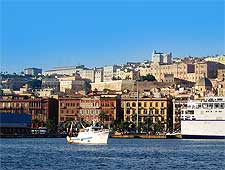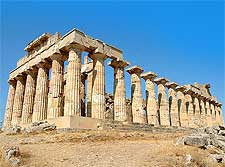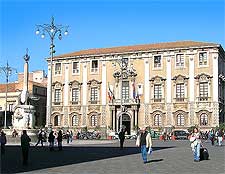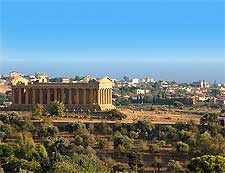Sicily History Facts and Timeline
(Sicily, Italy)

History remembers that the earliest inhabitants of Sicily were the Sikanians. Then, around 800 BC, Greeks and Phoenicians started to settle here, founding first the ancient city of Naxos and then Agrigento, Catania, Gela and also Siracusa. Meanwhile, the Carthaginians held Erice and expanded
Palermo and Solunto.
Whilst the Greeks and Phoenicians seemed to have lived fairly harmoniously, the Carthaginians were viewed with suspicion, particularly since they were seen to have empire-seeking pretensions. In 480 BC, the Carthaginians did indeed attempt to encroach on Greek territory, although they were thwarted at the Battle of Himera. Sicilian cities were also under threat from attack by more distant Greek forces.
By far the greatest threat was to come from
Rome. Roman troops were sent to occupy the north-eastern part of Sicily in 264 BC and in the next 50 years, they managed to consolidate their control over the entire island. Roman Sicily was a wealthy place. It remained heavily influenced by Greek traditions and culture. Indeed, it wasn't until the 4th century AD that Christianity finally started to make its mark here.
In the 5th century AD, the island was invaded for the first time by Vandals. More attacks followed, ending in the island's occupation in 476 AD. From the end of the 7th century AD, the island was part of Byzantium. Then, in 831 AD, a North African group of people, the Saracens, seized the island.

Early History of the Island
The Normans' first taste of Sicily was in the early 11th century, when they formed part of the Byzantine occupation of the eastern part of the island. Then, around 1064, Norman forces arrived under Roger de Hauteville, defeating the Saracen garrison at Messina. They later succeeded in capturing Palermo. As the self-styled 'Count of Sicily', Hauteville introduced a feudal system, along with an unusual degree of religious freedom.
As well as churches, there were also mosques and synagogues here. Court decrees usually appeared in several languages. In 1130, Roger II was crowned King of Sicily and Palermo was named as the capital. It is argued that during his reign, this was the most important kingdom in Europe, both in terms of its economy and politics. The island also served as a useful base for those taking part in the Crusades during the 12th century.
In 1198, Frederick II von Hohenstaufen became King of Sicily on account of his mother being the daughter of Roger II. Under Frederick's rule, the island enjoyed something of a 'golden age'. However, during the 13th century, the face of Sicily began to change. By this time, many of its Muslims had converted to Christianity and the Roman Catholic Church was now one of the island's largest landowners. The Teutonic Knights were already on the island by the 1190s and the Knights of Malta also gained more of a presence at this time.

Following Frederick's death, Sicily didn't fare quite so well at this time in its history. The coronation of Charles of Anjou signified the end of religious tolerance and ethnic diversity on the island. Two opposing factions grew up at this time - the Ghibellines, who supported the Holy Roman Emperor, and the Guelphs, who supported the Papacy and the Angevins.
By the late Middle Ages, Sicily was in the hands of the Spanish, who treated it as little more than a distant colony that could be exploited for the good of Spain. Sicily found itself more and more isolated and increasingly victim to corrupt nobility and the Inquisition. In the 16th and 17th centuries, under the rule of the Spanish Habsburgs, the island continued to suffer from misgovernment. In 1693, matters were made worse by a massive earthquake that struck the east coast. The Bourbons who ruled the island in the 18th century did little to improve matters.

History from the 19th Century to the Present Day
In 1806, the island came under British Administration for a brief period. A two-chamber parliament was established and feudal privileges were abolished. However, following the Napoleonic Wars, the island again found itself returned to Bourbon rule.
Then, in 1860, the Bourbons were defeated during the move towards the unification of Italy. Sicily was merged with the Kingdom of
Sardinia and then a year later, became part of the Kingdom of Italy. Unification did little to restore the island's fortunes. In the late 19th century, the Mafia was a key part of island life. Also known as La Costa Nostra, its influence extended over much of Sicily.
During World War Two, Allied forces invaded Sicily and in 1943, it put up little in the way of resistance. In 1946, the island became autonomous, with its own constitution, parliament and president. A few decades later, the island became infamous in 1992 as a result of the assassination of two anti-Mafia magistrates.
 History remembers that the earliest inhabitants of Sicily were the Sikanians. Then, around 800 BC, Greeks and Phoenicians started to settle here, founding first the ancient city of Naxos and then Agrigento, Catania, Gela and also Siracusa. Meanwhile, the Carthaginians held Erice and expanded Palermo and Solunto.
History remembers that the earliest inhabitants of Sicily were the Sikanians. Then, around 800 BC, Greeks and Phoenicians started to settle here, founding first the ancient city of Naxos and then Agrigento, Catania, Gela and also Siracusa. Meanwhile, the Carthaginians held Erice and expanded Palermo and Solunto.
 Following Frederick's death, Sicily didn't fare quite so well at this time in its history. The coronation of Charles of Anjou signified the end of religious tolerance and ethnic diversity on the island. Two opposing factions grew up at this time - the Ghibellines, who supported the Holy Roman Emperor, and the Guelphs, who supported the Papacy and the Angevins.
Following Frederick's death, Sicily didn't fare quite so well at this time in its history. The coronation of Charles of Anjou signified the end of religious tolerance and ethnic diversity on the island. Two opposing factions grew up at this time - the Ghibellines, who supported the Holy Roman Emperor, and the Guelphs, who supported the Papacy and the Angevins.